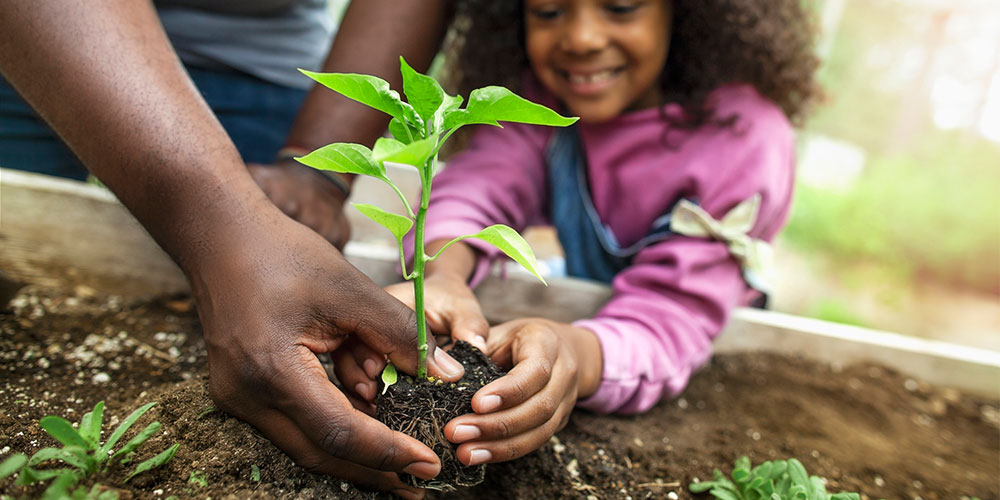Note: As we continue to battle the COVID-19 pandemic, please be advised that you might want to wait to use some of these strategies until students are back in school and your local health department lifts social-distancing restrictions.
For many students in the U.S., their experience of getting food consists of shopping at the grocery store and going out to a restaurant. They rarely have opportunities to experience the fascinating and rewarding process of seeing food transform from seed to table-ready.
Classroom gardens certainly require time, resources, and commitment. However, their educational benefits are well worth what you put into them.
Starting Your Garden
A classroom garden might look very different depending on your school’s location. Maybe it’s a traditional garden in your school’s existing green spaces. Or maybe it’s a small herb garden that can live on your classroom windowsill. Or field trips to a local community garden space.
Regardless of the size of your real estate (or your budget), here are some tips for how to start, from Growing Minds:
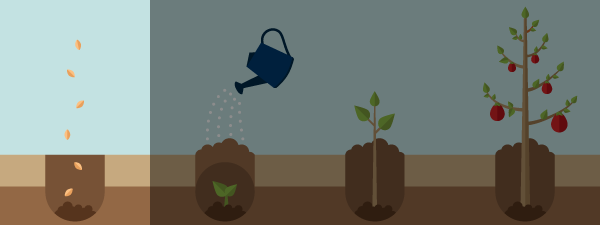
- Start early; start small. A garden is a big undertaking, so give yourself plenty of lead time for key issues such as: asking permission from your school leader (if necessary), contacting local greenhouses for donations or advice, sending out a wish list for supplies, and enlisting parent volunteers. Also, don’t feel like you have to plant several crops at once. For your first semester, you might choose one type of plant and then add to it over time.
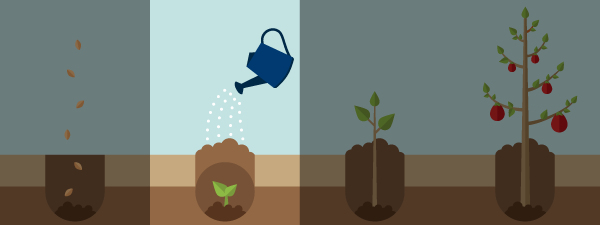
- Enlist help, especially at the beginning. Not a green thumb? That’s okay. Your local Master Gardener club or Garden Association will be able to tell you the type of soil and seeds that will work best in your area, plus tips for weed and pest control. Are your students young? You might want to ask parents or students from the local high school to help you prepare your garden bed for the first time.
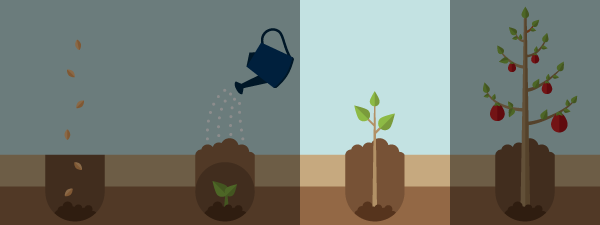
- Choose your crops. If you’re planting in cooler weather (e.g., September or March/April), Growing Minds suggests the following crops (which you can harvest before school lets out): lettuce, chard, radishes, collard greens, mustard greens, carrots, kale, spinach, peas, spring mix, beets, and potatoes. If you want to plant in May and harvest in the late summer or fall, consider the following: tomatoes, beans, peppers, squash, melons, pumpkins, zucchini, cucumber, or eggplant.
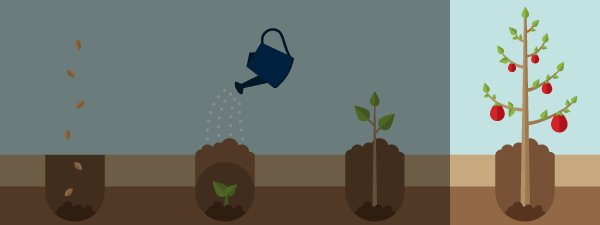
- Plan for long-term upkeep. Planting seeds is just the first step. To keep up your garden, you’ll need to think about weeding, mulching, and watering (if you don’t get enough rain). Think about where garden time might fit into your weekly routine and what you’ll do over the summer when you don’t have 20+ sets of helping hands.
For more tips like these, check out this free download from Growing Minds.
Teaching Nutrition
The CDC reports that nearly a fifth of U.S. children and adolescents struggle with obesity. There are numerous factors that contribute to this staggering number, but high on the list is the issue of nutrition. The Department of Agriculture recommends half our diet should consist of fruits and vegetables, but a quick survey of your students’ lunchboxes will quickly show that reality rarely reflects these proportions.
A classroom garden provides incredible opportunities to get your students excited about fruits and veggies. Kids Gardening suggests the following strategies to integrate nutrition lessons into your gardening project:
- Plant a rainbow. Nutritionists recommend eating a wide variety of fruits and veggies—the more colorful, the better. That’s because different plants produce a variety of types and levels of phytonutrients, which lead to both different colors and different health benefits. “Planting a rainbow” can expose your students to these myriad vegetables and get them in the habit of filling their plates with the nutrients their bodies need.
- Teach the parts of a plant. Let’s face it: Learning the parts of a plant from a textbook can be boring. Not to mention hard to remember. However, when students can touch and feel plants and watch their different parts grow, they’re more likely to remember them and make connections more easily. Plant parts can also help students understand the nutrient contents of different types of foods.
- Start a cooking program. Imagine if you themed your garden: a pizza garden (tomatoes, basil, oregano, peppers, onions), a smoothie garden (kale, strawberries, blueberries, mint), or a snack garden that allows you to eat fresh off the bud (cherry tomatoes, sugar snap peas, mini carrots, cucumbers). Your students will feel enormous satisfaction when they not only successfully nurture the plants, but also have the opportunity to cook and eat what they grew with their own hands.
Making STEM Connections
The Collective School Garden Network offers several ideas for activities connecting your classroom garden to your math and science curriculum. For example:
- Life science: Gardens provide a living example of several key life science concepts, including: life cycle and reproductive cycle of a plant; photosynthesis; pollination and germination; adaptation and environmental factors on plant growth; and more.
- Earth science: You can use a garden to simulate the impact of naturally occurring events. For example, you might track how weather impacts plant growth, the differences between different types of soil, and the effects of erosion.
- Physical science: Gardens lend themselves to practical experiments. For example, you could simulate the water cycle by covering a portion of the garden with plastic and watching water evaporate and condensate. Or you could measure the pH levels of different types of soil and track how these levels impact plant growth.
- Math: Gardens offer numerous opportunities to practice math skills such as: measuring and creating charts based on the growth rates of different plants; calculating the square footage needed to plant different types of crops; or calculating the amount of fertilizer and water needed for your garden.
Fostering Collaboration
In addition to numerous opportunities for academic connections, gardens can be a great social–emotional learning tool for students of all ages.
In How to Grow a School Garden, Arden Buck-Sporer and Rachel Kathleen Pringle remind us, “Numerous studies point to school gardens as a means of improving academic achievement, promoting healthy lifestyles, demonstrating the principles of stewardship, encouraging community and social development, and instilling a sense of place.”
A report from Rutgers found that:
- Gardening instills a consideration for living things. As students care for and watch plants grow, they will have a new appreciation for the fascinating and fragile processes of life. This lesson lends itself to key SEL skills like caring for others, taking on responsibility, and being conscientious of one’s impact on the environment.
- Gardening encourages kids to try new things. Anxiety is on the rise even among younger students, and such mental health issues can inhibit children from taking risks and getting out of their comfort zones. Gardening is a peaceful, low-risk way to try something new and can build students’ confidence to try more new things in the future.
- Gardening can improve interpersonal relationships. Whether because of academic struggles or other challenges, students can sometimes feel disconnected from their school and from their teachers and peers. A classroom garden is a prime opportunity for students to bond over a shared experience and feel more connected to their school community.
